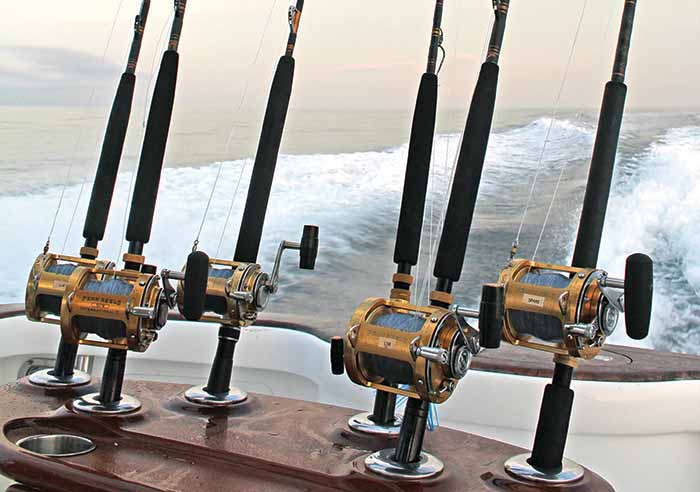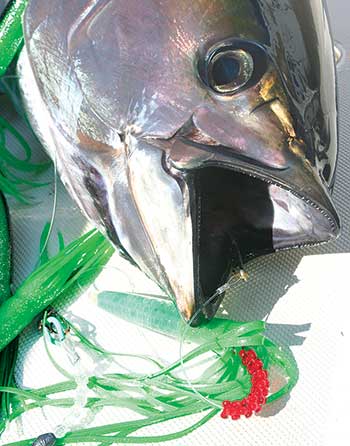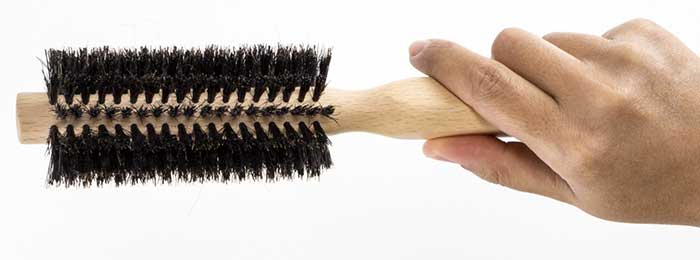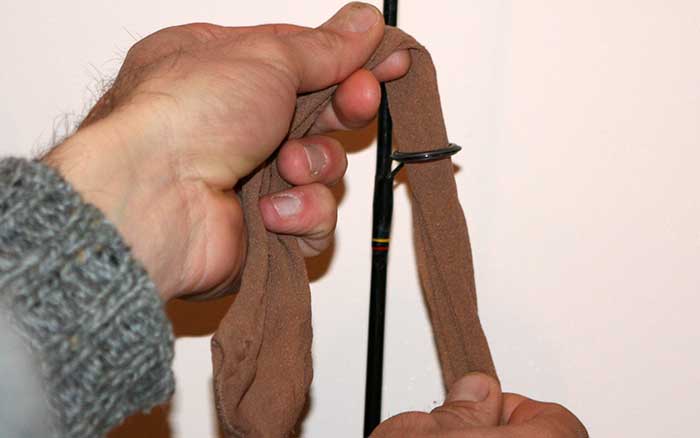Advertisement
It takes more than sharp hooks to out-catch everyone at the marina. Here's how to start.

Dragging your fishing line behind the boat, with nothing attached to the end, once or twice a month works great to remove line twists. (Photo: Lenny Rudow)
1. Re-spool every year for monofilament, and every three years for braid. You've probably noticed that monofilament often gets "memory" (springy coils set in) after sitting on a spool for several months. And you may also recognize that after a season of use, there's bound to be a weak spot or two somewhere in the line. But what many anglers don't realize is that monofilament loses strength with exposure to UV rays. Just sitting in daylight is all it takes to weaken, and after a season of use, that 20-pound test is more like 18-pound test. Braid is a bit heartier and doesn't weaken quite as dramatically with time and sunlight. Still, sooner or later it's bound to rub against your boat's hull, cross another fishing line, or become weakened in some other way. So after three seasons of use, savvy anglers strip their reels clean and start over with fresh fishing braid.

Sharp teeth nick lines. (Photo: Thinkstock).
2. Throw those hooks away. Yes, that's right — stop sharpening them after a couple of uses and just trash them. These days, high-quality hooks are chemically and laser sharpened. Once a few specks of rust appear, no matter how long you go at it with a file or stone, you'll never get that hook as sharp as it was when it first came out of the package.
3. Cut off the last five feet of fishing line after each and every trip. This is the part of your line that gets the most wear and tear, rubbing against shells, rocks, and (hopefully) fish teeth and spines. If you check it after every trip, you'll almost always notice a few nicks or frays. So just cut away those final five feet, then run the next five through your fingers to ensure you've eliminated all the weak spots. (Dispose of the line back onshore, in a receptacle, so it doesn't end up in the water, or better yet, recycle used line.)
4. Comb out the hairs of your bucktails, skirts, and parachutes. Any lure with hairs eventually becomes dirty and tangled. This not only affects the lure's appearance; it also changes its profile and action because the hairs don't move as freely. Comb them out, just as you'd comb your hair. In extreme cases, a spritz of hair detangler might be necessary; if you use it, be sure to thoroughly wash down the lure afterward to remove any perfumes and scents.

It's not just your hair that needs detangling. (Photo: Thinkstock)
5. Pantyhose can help you expose tiny nicks and cracks in your fishing rod's ceramic guide linings. These linings need to be completely smooth, or they'll cause friction and line wear as you cast and retrieve. To make sure they're in good shape, pull that pantyhose through the guides. If anything snags and rips, you'll know the linings' smooth surface has been damaged and needs replacing.

6. Remove clamped reels from the rod whenever they'll sit for more than a month. Reel clamps have a nasty habit of holding salt and contaminants against the reel seat, and if they sit in place for months on end, corrosion is the sure result. Whenever your rods and reels are going to sit for an extended period of time, remove the clamps and soak them down with a good corrosion-inhibitor (like Corrosion-X or Boeshield T-9).
7. Once or twice a month after a fishing trip, drag your fishing line behind the boat, with nothing attached to the end. Nothing works better, for removing the scourge of line twist. Remember that for this to work, the boat has to be moving relatively slowly, so it's best done at the end of the day, as you idle back through the slow-speed zone on your way into the marina. Five minutes or so should do the trick.
8. Keep a cedar block, a packet of silica gel, or a packet of Damprid in your tacklebox. These items absorb moisture, and tackleboxes see altogether too much moisture. Wet lures, salt spray, and even rain can keep your hooks and lures damp, and we all know what comes next — rust. Place any of these moisture-absorbers in your box to minimize corrosive effects.

9. Hang your spreader bars from the ends, not the middle. Hanging spreader bars (or any gang-lures with metal arms and monofilament leaders) is the best way to stow them, because it keeps the lines untangled and straightens out the kinks. But if you hang them from the center eye, with time the arms will droop and a bend sets in. Instead, prop up each end of the bar. The next time you deploy your spreaders, they'll run perfectly straight.
10. Calibrate your fishfinder's temperature gauge. We don't usually think of electronics as "tackle," but in this case, it most certainly is. Savvy anglers depend upon the fishfinder's temperature gauge every trip. But few are calibrated before they leave the factory, and most should be recalibrated seasonally. (See your owner's manual, or just Google it, to find instructions for your particular brand).
Stop! Wait! Noooo!
It's easy to trash your tackle by accident. Don't make any of these five tackle-maintenance mistakes — they may seem like good ideas, but trust us, you'll be doing more harm than good.
Life's A Drag: Never stow your reels with the drags cranked down tight. This can pinch the drag washers and leave tiny divots in them. The next time a fish starts peeling off line, the drag will be jerky instead of smooth.
Guided To Greatness: Stop putting hooks through the rod guides under tension. Not only can the hooks chip the guide liner; the constant tension and stress sometimes pops the liner right out of the eye.
Fatal To The Finish: Using a cleaner that contains ammonia, like Windex, on your fishing rods is a huge no-no. Ammonia causes the plasticizers in plastic parts and guide epoxy to leech out, and they'll turn brittle and yellowed. Within a year or two, they then crack and peel.
Oil's Well That Ends Well: Roller guides need lubricant, but that lube should never be oil. Oil-based lubes collect dust, and after they sit around for a few months, those rollers will become gummed up and sticky. Teflon-based spray lubes (like CRC Power Lube or StarBrite White Teflon) are a much better choice.Stop! Wait! Noooo! It's easy to trash your tackle by accident. Don't make any of these five tackle-maintenance mistakes — they may seem like good ideas, but trust us, you'll be doing more harm than good.
Spray Away: Never spray WD-40 on your fishing reels. If you spray it on your reel, you're bound to mist the line as well. Have you ever had a knot slip, without any apparent reason? This can certainly be a contributing factor. Instead of spraying WD-40 on your reel, spray a rag until it's soaked and wipe it on by hand.
